| ________________
CM . . .
. Volume XVIII Number 21. . . .February 3, 2012 
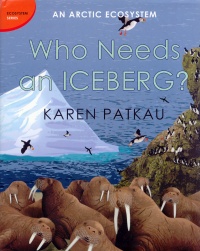 |
Who Needs an Iceberg? An Arctic Ecosystem. (Ecosystem Series).
Karen Patkau.
Toronto, ON: Tundra Books, 2012.
32 pp., hardcover, $19.99.
ISBN 978-0-88776-993-1.
Subject Headings:
Ecology-Arctic regions-Juvenile literature.
Arctic regions-Juvenile literature.
Grades 2-4 / Ages 7-9.
Review by Suzanne Pierson.
***½ /4
|
| |
|
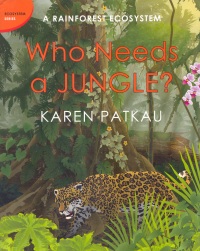 |
Who Needs a Jungle? A Rainforest Ecosystem. (Ecosystem Series).
Karen Patkau.
Toronto, ON: Tundra Books, 2012.
32 pp., hardcover, $19.99.
ISBN 978-0-88776-992-4.
Subject Headings:
Jungle ecology-Central America-Juvenile literature.
Rain forest ecology-Central America-Juvenile literature.
Jungles-Central America-Juvenile literature.
Rain forests-Central America-Juvenile literature.
Grades 2-4 / Ages 7-9.
Review by Suzanne Pierson.
***½ /4
|
| |
|
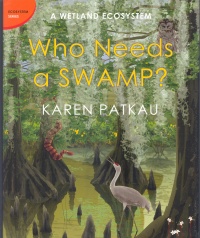 |
Who Needs a Swamp? A Wetland Ecosystem. (Ecosystem Series).
Karen Patkau.
Toronto, ON: Tundra Books, 2012.
32 pp., hardcover, $19.99.
ISBN 978-0-88776-991-7.
Subject Headings:
Swamp ecology-North America-Juvenile literature.
Wetland ecology-North America-Juvenile literature.
Swamps-North America-Juvenile literature.
Wetlands-North America-Juvenile literature.
Grades 2-4 / Ages 7-9.
Review by Suzanne Pierson.
***½ /4
|
| |
|

excerpt:
Jungle Trees Protect the Land
The rainforest is disappearing. Loggers cut down trees. Workers clear land for farms and cattle ranches, even though the soil is poor for pastures or crops.
Tree and plant roots cling to fine jungle topsoil. Without them, rain washes topsoil away into nearby streams and rivers. The uncovered soil below then dries out and hardens. It becomes even less nourishing. Topsoil particles then settle to the bottom. If this "silt" builds up, water can overflow and flood land. Silt can also pollute drinking water, clog irrigation systems, and endanger living things that depend on streams and rivers. (From Who Needs a Jungle?)
Nonfiction picture books are not nearly as common as they once were, but author and illustrator Karen Patkau proves that the genre is not dead. Her beautiful illustrations and maps present information in an easy to understand format for young readers. For example, in Who Needs a Swamp?, Patkau is able to present a visual representation of the role a swamp plays in helping to filter polluted river water as it passes through the swamp before the water continues downstream.
 Each book includes simple text for beginning nonfiction readers supported by detailed illustrations of the plant and animal life in each ecosystem. The books also include a world map to identify the locations of the different ecosystems around the world. Patkau also identifies the specific area of the Arctic, jungle or swamp ecosystem that is described in the books.
Each book includes simple text for beginning nonfiction readers supported by detailed illustrations of the plant and animal life in each ecosystem. The books also include a world map to identify the locations of the different ecosystems around the world. Patkau also identifies the specific area of the Arctic, jungle or swamp ecosystem that is described in the books.
Also included at the back of each book is additional information about some of the ecosystem's inhabitants. These highlights consist of a brief description accompanied by an illustration of the plant or animal. This additional information section is followed by a glossary. Words in the glossary are not highlighted in bold in the text, nor are they linked to a page number.
One of the weaknesses of the books in this series is that they do not include a simple table of contents or index. For example, in Who Needs an Iceberg?, an illustration and description of phytoplankton are included at the back of the book, but, if you want to find the information about phytoplankton in the body of the book, you have to search page by page.
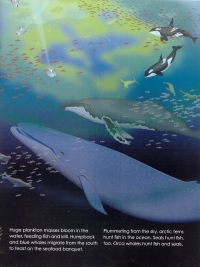 One of the strengths of the series is that the books are organized to include similar content. For example, each book opens with an overview of the ecosystem titled "Welcome to the Arctic," (or "Jungle" or "Swamp"). They also include descriptions of what it is like to live in each ecosystem, a food chain, examples of life cycles, and an explanation of the importance of each ecosystem. Each book ends with the answer to the question, "Who needs an iceberg (or "Jungle" or "Swamp")? We all do." When working with small groups of young researchers, it would be possible to have the students find the answers to the same higher level questions for the different ecosystems.
One of the strengths of the series is that the books are organized to include similar content. For example, each book opens with an overview of the ecosystem titled "Welcome to the Arctic," (or "Jungle" or "Swamp"). They also include descriptions of what it is like to live in each ecosystem, a food chain, examples of life cycles, and an explanation of the importance of each ecosystem. Each book ends with the answer to the question, "Who needs an iceberg (or "Jungle" or "Swamp")? We all do." When working with small groups of young researchers, it would be possible to have the students find the answers to the same higher level questions for the different ecosystems.
A bonus is that the inside of each of the dust jackets for these hardcover books is a poster. If you are willing to part with the dust jacket on the book, you will have lovely posters for your classroom or library.
Who Needs an Iceberg? examines an ecosystem that is changing so rapidly that the young readers of this book may actually be reading about the past. Patkau portrays a polar bear hunting ringed seal on the coastal ice, but the message at the end of the book identifies the problem. The Arctic is changing because of this "global warming." The Arctic Ice Cap is melting. Polar bear hunting grounds are shrinking. The home of arctic people is threatened.
Who Needs a Jungle? describes the important role of the rainforest ecosystem in providing oxygen, food, medicinal ingredients, and raw materials that we use every day. It also explains the role that jungle trees play in protecting the land and how jungles affect weather.
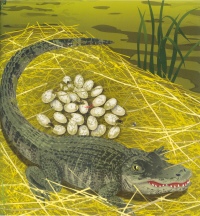 Who Needs a Swamp? looks at swamps as sponges absorbing rainwater and protecting farmland. Swamps slow down the water flowing across the surface of the earth, preventing further erosion by water. This book also explains how swamps clean dirty water and the role swamps play in the earth's water cycle.
Who Needs a Swamp? looks at swamps as sponges absorbing rainwater and protecting farmland. Swamps slow down the water flowing across the surface of the earth, preventing further erosion by water. This book also explains how swamps clean dirty water and the role swamps play in the earth's water cycle.
All of the books in this series contain valuable information supported with illustrations that help young readers understand the content. The message in each is clear. We need to care about these different ecosystems.
Highly Recommended.
Suzanne Pierson is a retired teacher-librarian, currently instructing Librarianship courses at Queen's University in Kingston, ON.

To comment
on this title or this review, send mail to cm@umanitoba.ca.
Copyright © the Manitoba Library Association. Reproduction for personal
use is permitted only if this copyright notice is maintained. Any
other reproduction is prohibited without permission.
NEXT REVIEW |
TABLE OF CONTENTS FOR THIS ISSUE
- February 3, 2012.
AUTHORS |
TITLES |
MEDIA REVIEWS |
PROFILES |
BACK ISSUES |
SEARCH |
CMARCHIVE |
HOME |



 Each book includes simple text for beginning nonfiction readers supported by detailed illustrations of the plant and animal life in each ecosystem. The books also include a world map to identify the locations of the different ecosystems around the world. Patkau also identifies the specific area of the Arctic, jungle or swamp ecosystem that is described in the books.
Each book includes simple text for beginning nonfiction readers supported by detailed illustrations of the plant and animal life in each ecosystem. The books also include a world map to identify the locations of the different ecosystems around the world. Patkau also identifies the specific area of the Arctic, jungle or swamp ecosystem that is described in the books.
 One of the strengths of the series is that the books are organized to include similar content. For example, each book opens with an overview of the ecosystem titled "Welcome to the Arctic," (or "Jungle" or "Swamp"). They also include descriptions of what it is like to live in each ecosystem, a food chain, examples of life cycles, and an explanation of the importance of each ecosystem. Each book ends with the answer to the question, "Who needs an iceberg (or "Jungle" or "Swamp")? We all do." When working with small groups of young researchers, it would be possible to have the students find the answers to the same higher level questions for the different ecosystems.
One of the strengths of the series is that the books are organized to include similar content. For example, each book opens with an overview of the ecosystem titled "Welcome to the Arctic," (or "Jungle" or "Swamp"). They also include descriptions of what it is like to live in each ecosystem, a food chain, examples of life cycles, and an explanation of the importance of each ecosystem. Each book ends with the answer to the question, "Who needs an iceberg (or "Jungle" or "Swamp")? We all do." When working with small groups of young researchers, it would be possible to have the students find the answers to the same higher level questions for the different ecosystems.
 Who Needs a Swamp? looks at swamps as sponges absorbing rainwater and protecting farmland. Swamps slow down the water flowing across the surface of the earth, preventing further erosion by water. This book also explains how swamps clean dirty water and the role swamps play in the earth's water cycle.
Who Needs a Swamp? looks at swamps as sponges absorbing rainwater and protecting farmland. Swamps slow down the water flowing across the surface of the earth, preventing further erosion by water. This book also explains how swamps clean dirty water and the role swamps play in the earth's water cycle.